
Bro Church is a medieval era Lutheran church at Bro on the Swedish island Gotland. Situated on what was possibly a pre-Christian sacred site, the presently visible church was built during the 13th century. Stylistically, its architecture shows a mix of Romanesque and Gothic elements. It still contains some medieval furnishings, including a baptismal font by Sigraf, and murals. The church belongs to the Väskinde parish in the Diocese of Visby of the Church of Sweden.

Grötlingbo Church is a medieval church in Grötlingbo on the Swedish island Gotland. The stately Gothic church contains elements of a Romanesque frieze, incorporated from an earlier church building on the same site. Görtlingbo Church lies within the Diocese of Visby.

Stenkyrka Church is a medieval church in Stenkyrka on the Swedish island of Gotland. Although the current church dates from the 13th century, it was probably preceded by one of the earliest churches on Gotland at this site. Stenkyrka Church is dominated by its large tower and its interior is decorated with medieval murals. It belongs to the Church of Sweden and lies in the Diocese of Visby.

Lye Church is a medieval church on Gotland, Sweden. The oldest parts of the church date from the last quarter of the 12th century, and the last major addition was the disproportionately large chancel, built during the second quarter of the 14th century by a workshop known by its notname as Egypticus. The workshop was also responsible for constructing the largest of the church portals, which is also decorated with Gothic stone sculpture. The tower portal contains sculptures attributed to the Romanesque sculptor Sigraf. The church has been little altered since the end of the Middle Ages. Lye Church contains the largest preserved set of medieval stained glass windows in the Nordic countries, and its interior is also decorated by medieval wall paintings, uncovered in the 1950s. The altarpiece is from 1496, and the church also contains a triumphal cross from the same period.
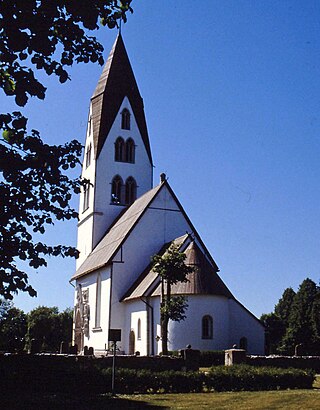
Stånga Church is a medieval church in Stånga on the Swedish island of Gotland. The site of the church has probably been considered sacred since before the Christianization of Scandinavia.

Hemse Church is a medieval Lutheran church in Hemse on the island of Gotland. Preceded by the most well-preserved early stave church discovered in Sweden, the current church dates mainly from the 13th century. It contains sets of medieval murals as well as some medieval furnishings. It is part of the Diocese of Visby.

Eke Church is a medieval church in Eke on the Swedish island of Gotland. The church was built during the 12th and 13th century, with only smaller additions and changes made later. Inside, several medieval murals survive. The church is used by the Church of Sweden and lies in the Diocese of Visby.
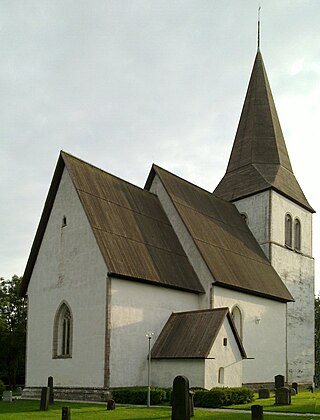
Etelmhem Church is a medieval church on the Swedish island of Gotland. The largely Gothic church contains medieval murals and a 12th-century baptismal font by the sculptor Hegvald. The church is used by the Church of Sweden and part of Diocese of Visby.

Buttle Church is a medieval church in Buttle on the Swedish island of Gotland. It is one of the more well-preserved Romanesque churches on Gotland, and contains both a number of medieval furnishings as well medieval murals. Buttle Church belongs to the Diocese of Visby of the Church of Sweden.
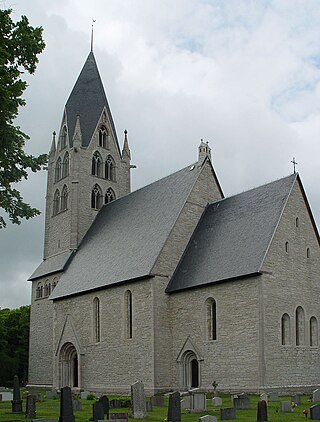
Dalhem Church is a medieval church in Dalhem on the Swedish island of Gotland. Built in the 13th and 14th century, the church underwent major changes during a renovation at the turn of the 19th–20th centuries. Dalhem Church lies in the Diocese of Visby of the Church of Sweden.

Ekeby Church is a medieval church in Ekeby on the Swedish island of Gotland. The oldest parts date from the 12th century, and the church has been little altered since the end of the 13th century. Its interior is richly decorated with medieval murals. It belongs to the Church of Sweden and lies in the Diocese of Visby.

Endre Church is a medieval church in Endre on the Swedish island of Gotland, in the Diocese of Visby, built from the 12th to early 14th century. It contains medieval murals and several medieval furnishings, and belongs to the Church of Sweden.

Rone Church is a medieval church in Rone on the Swedish island of Gotland. The Gothic church contains a number of medieval murals. It is part of the Church of Sweden and lies in the Diocese of Visby.
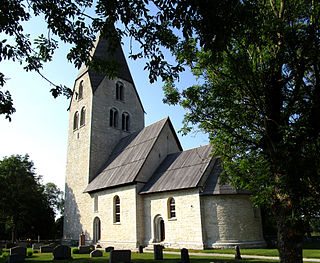
Ganthem Church is a well-preserved Romanesque church in Ganthem on the island of Gotland. It contains murals from the 15th century as well as a number of medieval furnishings. It lies in the Diocese of Visby (Sweden).

Lojsta Church is a medieval church in Lojsta on the Swedish island of Gotland. The well-preserved church contains several sets of medieval murals. It belongs to the Diocese of Visby within the Church of Sweden.

Mästerby Church is a medieval church in Mästerby on the Swedish island of Gotland. It is richly decorated with medieval murals. Mästerby Church belongs to the Diocese of Visby.

Gerum Church is a medieval church in Gerum on the Swedish island of Gotland, built between c. 1200 and 1300. It is used by the Church of Sweden.
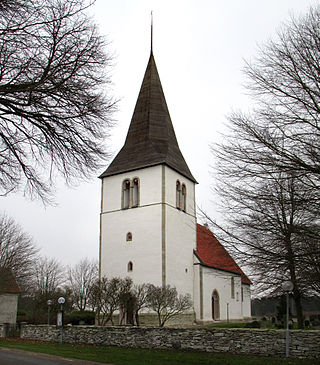
Silte Church is an almost unaltered medieval church on the Swedish island of Gotland. Silte Church was built during the 13th century and contains a number of medieval fittings as well as murals. It belongs to the Church of Sweden and lies in the Diocese of Visby.

Stenkumla Church is a medieval church in Stenkumla on the island of Gotland, Sweden. It belongs to the Diocese of Visby. During the Middle Ages, the church was dedicated to Saint Lawrence.

Viklau Church is a medieval church on Gotland, Sweden. It is a well-preserved Romanesque church in which several medieval items have been preserved. The most famous of these is the Viklau Madonna, today housed in the Swedish History Museum in Stockholm.























